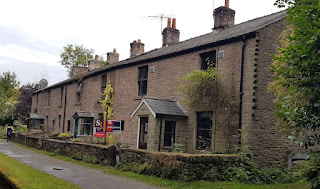The Hovis Mill is now converted to 37 apartments but alongside is a new development for retirement people - a number are now coming up for resale (the present term seems to be 'preloved' homes!). A small one bed apartment costs around £275K whilst a larger three bed is on offer at £485K (NB there are various other charges to met arising from the nature of a retirement community scheme) From what we could see, this seems to be a well-designed and, as yet, well run scheme. The photo also shows the pontoons where we had a much better night and we awoke to hot water again even if the readings confirmed that the batteries definitely needed replacing.
The shopping centre is down a steep hill and up almost as much on the other side. Near the bottom of Brook Street we noticed this former mill, fewer floors than many textile mills but we suspect it was (given the history of industry in the town) a silk mill. We have found very few references to it - it is now apartments.
After reaching the bottom of the valley we then had to walk uphill again, following the main shopping street. At the top a wide open market square has the imposing Town Hall as a backdrop (alongside the former police station)
Close by is the main parish church, although the town does seem to have had a particularly large number of churches and chapels of all sorts and types.
Inside, the main nave is a large and imposing space. Looking back at the modern narthex, it gives a scale through its three levels of extra rooms and facilities.
he church is noted for the number and scale of memorials, many of the Savage family that were a prominent family from 14C onwards. On the left above is Sir John Savage V (1444–1492) who fought for Henry Tudor at the Battle of Bosworth in which he played a prominent role. He died at the Siege of Boulogne in the service of the new king who was in dispute with the pope.
This is Sir John Savage VIII - the memorial has the wife (on the inner side) higher than him as she was of even nobler birth and outranked him!
Earl Rivers, Viscount Savage (d 1694) has a very elaborate memorial in the main chancel but oddly it has a lot of information about his two wives (the first especially was better connected than he) and nothing much about the Earl.
Getting out onto the main channel was a bit easier than getting in - except that we had to hover as two boats emerged through the nearby bridge - and a stiff breeze made keeping station 'interesting'.
The canal follows the edge of the town for about another two miles with numerous bridges but the sky was clear and the sunshine was almost hot.
We have used this bridge to illustrate a previous blog (at least once) but make no apology for including it again. From the oldest maps we have the bridge is likely to have been here since the canal was built but we are not sure why the towpath changes sides at this point. It makes sense to be on the side opposite the mills, such as Hovis, and other canal related industry but not obvious why it now reverts to the other bank. The main part of the bridge was built just as a simple accommodation bridge for Foden Bank Farm.
Soon after, we emerged from the town into open countryside with a splendid view of the hills in the distance behind us.
The next two road bridges are Old and New Leek Road. (The photo is New Road) A casual glance at today's OS map might suggest that Leek New Road is a modern, perhaps mid 20C, improvement scheme as the Old Road does look rather winding as it runs south out of the town and the New Road is remarkably straight. Surprising therefore to find that both the road and the bridge are on maps from just at the end of the 19C. A parish history for Sutton indicates that the turnpike (Leek New Road) was completed in 1826 to make coaching traffic speedier.
Alongside is one of the milestones - this one is much clearer on both faces (good sunshine helps on one side)

















































